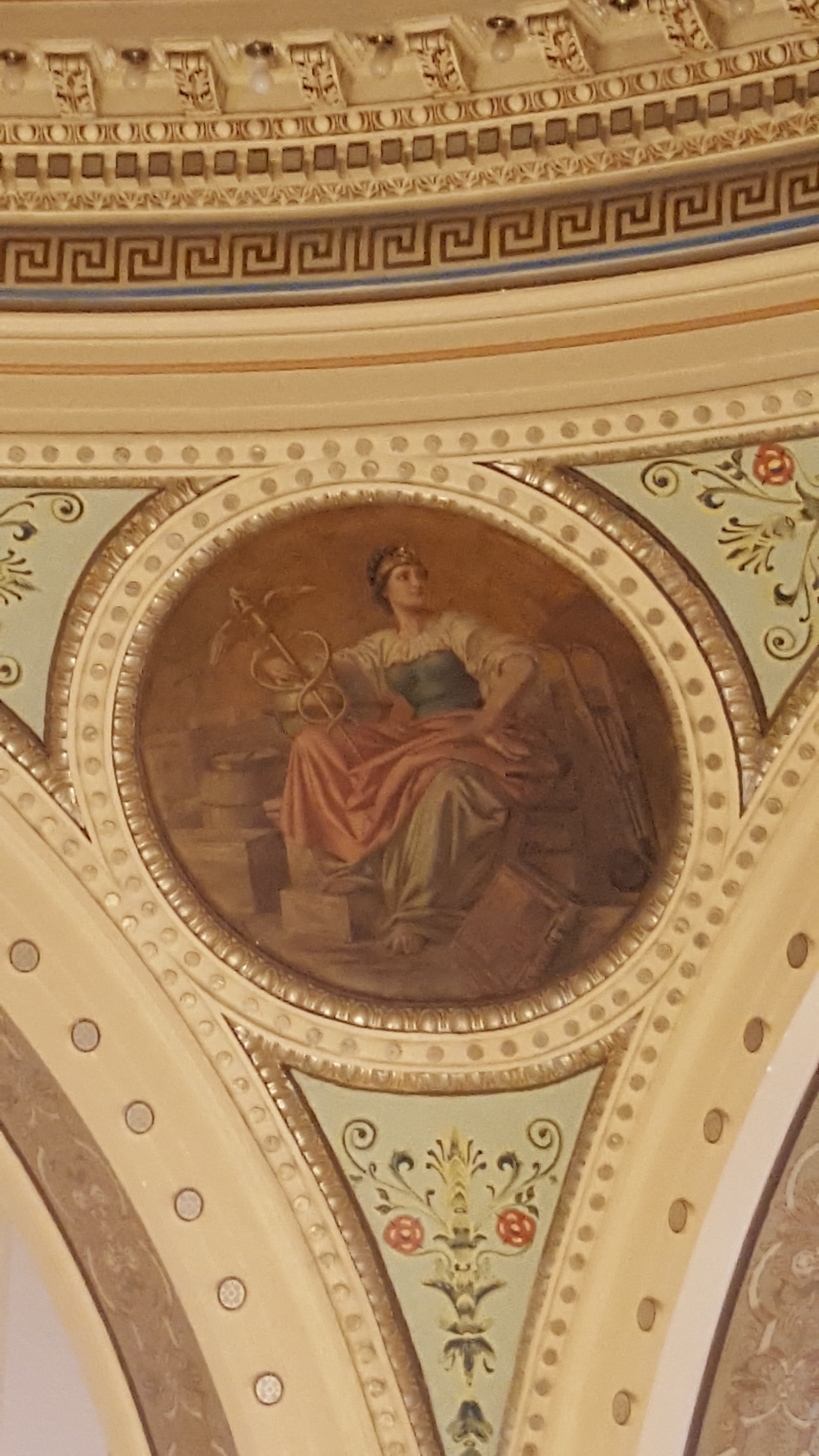Franz Rohrbeck, German Panorama Artist and the Court House Murals
The First Court House and Jail at Manitowoc Rapids mural, painted by Franz Rohrbeck in 1912, is located in the west staircase at the Manitowoc County Court House.
The Medicine medallion by Franz Rohrbeck is located in the domed Rotunda at the Manitowoc County Court House.
Franz Edward Rohrbeck was born in Torgau, Province of Saxony, Prussia on December 23, 1852. He trained as an artist at the Berlin Academy of Arts and specialized in portraits.
In 1885, Rohrbeck and other German artists, were hired by German-born Chicago businessman William Wehner to join the American Panorama Company at its Wells Street studio in Milwaukee. The firm created huge historical and religious-themed paintings that traveled throughout America.
Rohrbeck was one of about 20 German artists commissioned to paint the panorama The Battle of Atlanta, which depicts the 1864 Civil War battlefield in a vivid, true-to-life style. Rohrbeck, a specialist in painting human figures, depicted Confederate troops in battle scenes. As was customary for this art form, the panorama painting (also known as a cyclorama) was enormous, measuring 50 feet tall and 385 feet long, or about five stories high and longer than a football field. With paint, the panorama canvas weighed around 18,000 pounds.
In 1898, after the Spanish American War, Rohrbeck and other panorama artists went to San Francisco to paint The Battle of Manila.
As motion pictures became popular, panoramas ended as a form of entertainment. Some artists returned to Germany or moved to other American cities. Rohrbeck stayed in Milwaukee with his wife Greta Diez (or Dietz) and their four children: Carl, Elsie, Frank and Margaret. Like other German artists, he painted frescos and murals for churches, residences and public buildings in the Midwest and around the country. He also produced smaller art works and portraits. Rohrbeck was a member of the Society of Milwaukee Artists, later known as the Wisconsin Painters & Sculptors.
In December 1911, a contract for $8,000 from the County Board of Supervisors was awarded to the Milwaukee firm of Associated Artists to decorate the Beaux Arts-style Manitowoc County Court House, completed in 1907. In 1912, Rohrbeck painted four decorative medallions that flank massive third floor arches in the domed Rotunda. The allegorical paintings depict Agriculture, Industry, Liberty/Justice and Medicine.
Rohrbeck also painted a large framed mural for the south wall of the west landing between the second and third floors. It depicts the First Court House and Jail at Manitowoc Rapids in 1840. The oil painting on canvas is signed “F. Rohrbeck” near the lower right corner. The Medicine medallion also bears his signature.
A similar-sized framed mural on the opposite, or north, wall depicts a panoramic view of Manitowoc from Roefes Hill (present site of Lincoln High School), looking north in 1882. This canvas painting is by Franz Biberstein, a German landscape artist. Both Rohrbeck and Biberstein had recently painted murals of local historical scenes at the Brown County Court House, Green Bay, completed in 1911.
Rohrbeck died at the age of 66 on January 5, 1919. He is buried in Wanderers Rest Cemetery, Milwaukee.
Afficionados of local history and art history are encouraged to visit the Brown and Manitowoc County Court Houses and view the paintings by these skilled German artists. Other paintings by Rohrbeck decorate court houses in Lancaster (Grant Co.) and Monroe (Green Co.), Wisconsin; Fairmont (Martin Co.), Minnesota; and Montesano (Grays Harbor Co.), Washington.
Bob Fay is a former executive director of the Manitowoc County Historical Society.



